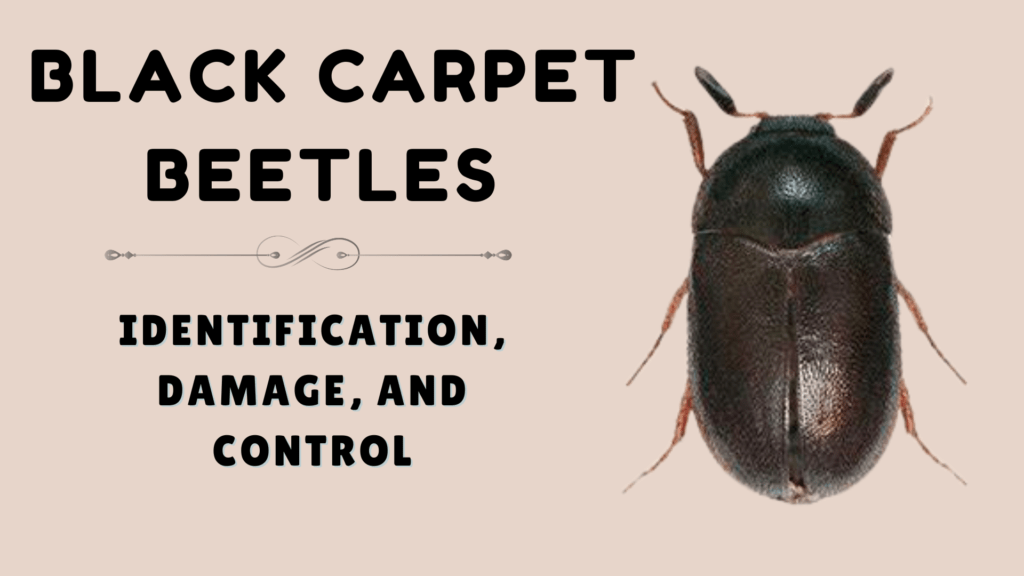
Discovering tiny, dark beetles in your home can be unsettling—especially when you realize they might be black carpet beetles. These small pests are notorious for damaging fabrics, carpets, and stored items.
This guide will help you identify black carpet beetles, understand the damage they cause, and learn effective control methods to protect your belongings.
Identification: What Do Black Carpet Beetles Look Like?
Black carpet beetles (Attagenus unicolor) are small, oval-shaped insects. Here’s how to recognize them:
Size: About 1/8 to 3/16 inch long (3–5 mm).
Color: Shiny black or dark brown.
Shape: Oval and slightly elongated.
Larvae: Fuzzy, carrot-shaped, and brown or golden, often mistaken for small caterpillars.
Adult vs. Larvae: Adults are the most visible, but larvae cause most of the damage.
You may find adults near windows or light sources, while larvae hide in dark, undisturbed areas like closets, under furniture, or inside stored boxes.
Damage: What Harm Do Black Carpet Beetles Cause ?
Black carpet beetles are destructive pests, especially in their larval stage. They feed on a variety of natural fibers and materials:
Fabrics: Wool, silk, cotton, and synthetic blends (if soiled with food or sweat).
Carpets and Rugs: Natural fibers are at risk.
Stored Items: Furs, feathers, leather, and even stored food products.
Other Materials: Upholstered furniture, clothing, and bedding.
Signs of an infestation include:
- Holes or irregular damage in fabrics and carpets.
- Shed larval skins in undisturbed areas.
- Tiny, dark beetles or larvae spotted in your home.
- Black Carpet Beetles vs. Other Pests
| Feature | Black Carpet Beetle | Clothes Moth |
| Appearance | Shiny black, oval | Dull, buff-colored, small wings |
| Larvae | Fuzzy, brown/golden | Creamy white, worm-like |
| Damage | Holes in fabrics, rugs | Similar, but prefers wool |
| Behavior | Attracted to light, hides in dark | Prefers dark, undisturbed areas |
How to Control and Prevent Black Carpet Beetles
Taking prompt action is crucial to prevent extensive damage. Here’s how to control and prevent black carpet beetle infestations:
Regular Cleaning: Vacuum carpets, rugs, and upholstery frequently, especially in hidden areas.
Proper Storage: Store woolens, furs, and other susceptible items in sealed containers or bags.
Launder Fabrics: Wash clothing and bedding regularly, especially before storing for long periods.
Reduce Food Sources: Keep pet food, birdseed, and other organic materials in airtight containers.
Inspect Secondhand Items: Check used furniture, clothing, and rugs for signs of beetles or larvae before bringing them inside.
Seal Entry Points: Repair screens and seal cracks to prevent beetles from entering your home.
Professional Pest Control: If the infestation is severe or persistent, contact a pest control expert for targeted treatments.
Also read:
Carpenter Ants vs Termites: Which One’s Worse?
Wood-Boring Beetles: Identification, Damage, and Control
What to Do If You Find Black Carpet Beetles
Identify the Source: Locate where the beetles or larvae are most active.
Clean Thoroughly: Vacuum and clean all affected areas.
Dispose of Infested Items: If possible, discard heavily infested items to prevent spread.
Monitor and Repeat: Continue to monitor for signs of beetles and repeat cleaning as needed.
Final thoughts
Black carpet beetles may be small, but they can cause significant damage to your home’s fabrics and stored goods. By learning how to identify them, recognizing the signs of damage, and implementing effective control measures, you can protect your belongings and keep your home beetle-free.
FAQ’s
Q: Are black carpet beetles dangerous to humans?
A: Black carpet beetles are not considered dangerous to people. They do not bite or sting, but some individuals may experience skin irritation from the bristly hairs of beetle larvae.
Q: What attracts black carpet beetles to a home?
A: These beetles are drawn to natural fibers, food debris, and stored goods. They may enter homes through open windows, doors, or on infested items like clothing, rugs, or furniture.
Q: How can I spot a black carpet beetle infestation?
A: Infestations are often detected by finding small, irregular holes in fabrics, rugs, or upholstery, as well as by seeing the beetles themselves or their larvae in dark, undisturbed areas.
Q: What is the lifecycle of a black carpet beetle?
A: Black carpet beetles go through four stages: egg, larva, pupa, and adult. The larval stage is the longest and most destructive, as it is when most feeding and damage occur.
Q: Can black carpet beetles damage synthetic fabrics?
A: They primarily target natural materials, but larvae may also feed on synthetic fabrics if they are soiled with food, sweat, or other organic matter.
Q: What should I do if I find black carpet beetles in my home?
A: Start by thoroughly cleaning affected areas, vacuuming carpets and upholstery, and storing susceptible items in sealed containers. For persistent issues, consider contacting a pest control professional.
Q: Are there products or traps that help control black carpet beetles?
A: Yes, pheromone traps and glue traps are available to monitor and reduce beetle numbers. Regular cleaning and proper storage are also effective prevention methods.
Q: How long does it take to get rid of black carpet beetles?
A: The time required depends on the extent of the infestation. With consistent cleaning, storage, and monitoring, most small infestations can be controlled within a few weeks.
Q: Can black carpet beetles spread diseases?
A: There is no evidence that black carpet beetles spread diseases to humans. Their main risk is causing damage to household items.

